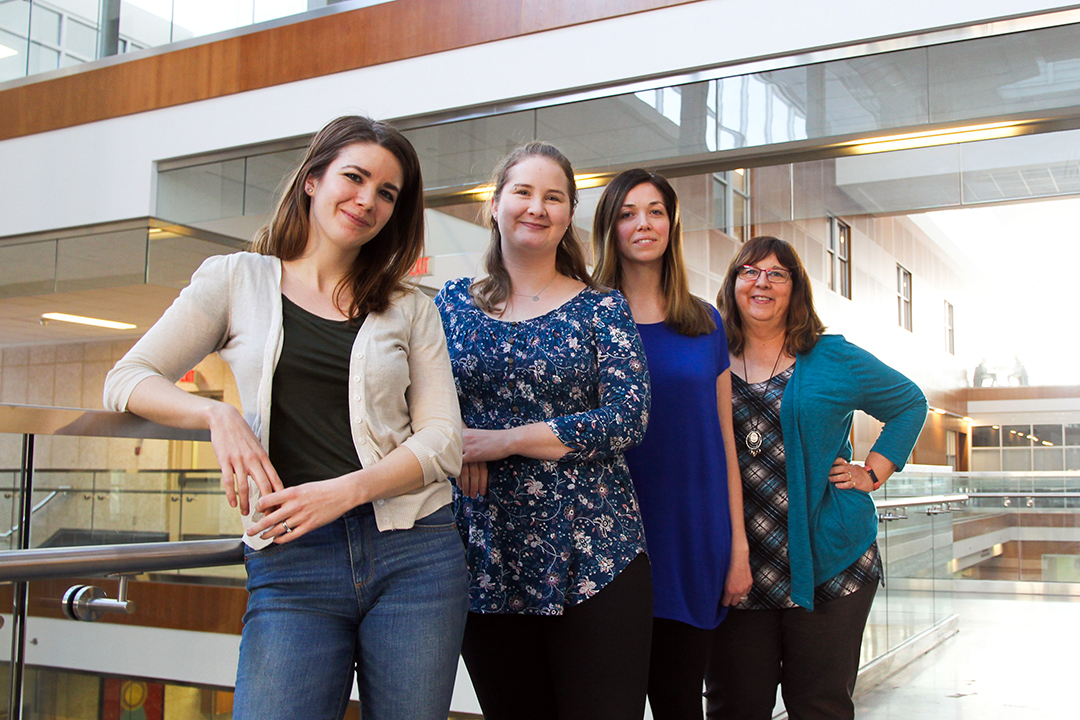“Each year more than 1,000 students from the Colleges of Dentistry, Medicine, Nursing, Pharmacy and Nutrition, Veterinary Medicine, and the School of Physical Therapy, participate in simulation-based education,” said Debbie Briere, CLRC manager since 1997.
That number of students, Briere continued, experience immersive, real-life scenarios to develop skills in patient and client communication, clinical techniques and teamwork, all in a safe learning environment.
“Studies have shown that simulation-based learning ultimately improves patient safety,” said Briere.
A key part of improving learning and patient outcomes at the CLRC are simulated patients (SPs).
SPs, Briere explained, are people trained to accurately and consistently portray the physical symptoms, emotions, concerns and personal history of a patient. Through role playing interactions, SPs help students with learning and assessment skills.
Briere said the program has been so successful that it has grown from 50 SPs in 1997—managed by herself and one other colleague—to more than 300, with three full-time co-ordinators: Tamara Hominuke, Amanda Leddy and Lindsay Tarnowetzki.
The trio of co-ordinators works to meet the learning objectives and students’ needs by training and standardizing large numbers of SPs. The number of SPs isn’t the only area of growth for the program—from May to December last year, more than 2,000 simulated interactions took place.
Those interactions range from students collecting patient history, conducting physical exams, communication sessions on breaking bad news, to participating in simulated real life emergency events. A select number are highly trained to teach students a patient-centred approach to sensitive physical exams of male and female genital and urinary systems.
James Komar, who has been with the CLRC since 2003 and has participated as an SP in everything from basic interviews to sensitive physical exams, has seen the program grow in complexity.
“I volunteered because I’m gay and I felt that besides the technological side of medicine, there’s the human side,” said the 85-year-old Komar. “I find it fulfilling that I’m able to give something back and I’ve also learned things. I’m fortunate that I’m in very good health—and I have an adventurous spirit.”
In addition to preparing SPs for a busy academic year of courses and exams, the co-ordinators look for partnerships with local organizations to reach out to community members who may be interested in working with students as an SP.
A particular focus, because of Saskatchewan’s growing diversity, is to have a cohort of SPs that reflects the diverse population in which students will one day practice. This also allows students to see more simulations that incorporate a wide range of interactions, including the experiences and perspectives of those who are part of local Indigenous communities, LGBTQ2S+, and newcomers to Canada.
“It is important to us to partner with our Indigenous community members, create thoughtful and respectful dialogue, as well as include them in our process of recruiting and training Indigenous SPs,” said Hominuke. “Working collaboratively with Indigenous Peoples, focusing on health issues from their peoples’ perspective will prepare all our future health-care providers to more fully understand and work with our Indigenous community members.”
The Open Door Society, Global Gathering Place and OUT Saskatoon are also involved in the program. Clients of these organizations have responded enthusiastically to the CLRC’s outreach, said Tarnowetzki.
“I’ve gotten a lot of responses from the community because they feel very strongly about their health and receiving culturally sensitive health care, which has historically been a challenge,” said Tarnowetzki about LGBTQ2S+. “It’s also valuable for students to meet people from diverse communities even if the simulation isn’t specifically focused on their backgrounds or identities.”
Lyle Weber, an SP who discovered the CLRC by way of OUT Saskatoon, said making a non-visible minority more visible was a big motivation for him to join the program.
“But that doesn’t play into it, most of the time I’m just another patient,” Weber said, adding that he’s found this experience to be educational and enlightening. “It’s amazing how light-hearted, kind and caring the students are, despite the pressures of school. It’s a blast.”
